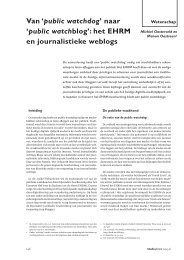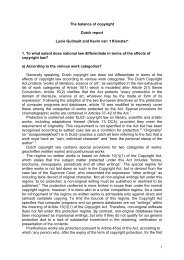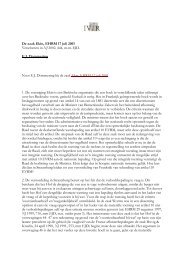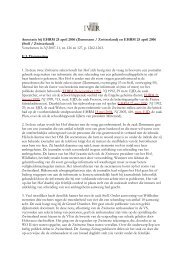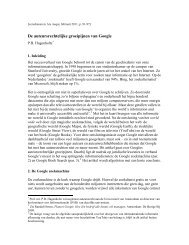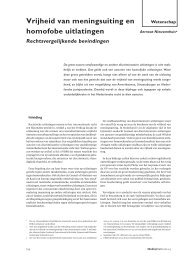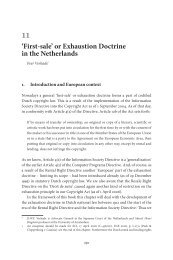unravelling the myth around open source licences - IViR
unravelling the myth around open source licences - IViR
unravelling the myth around open source licences - IViR
You also want an ePaper? Increase the reach of your titles
YUMPU automatically turns print PDFs into web optimized ePapers that Google loves.
10. The licence must be technology-neutral.<br />
The OSD has become a widely cited standard for determining which <strong>licences</strong> are ‘<strong>open</strong><br />
<strong>source</strong>’. Most people consider today <strong>the</strong> terms <strong>open</strong> <strong>source</strong> and free software to be synonymous.<br />
Stallman does not agree with <strong>the</strong> way in which <strong>the</strong>se terms are used interchangeably, since in his<br />
opinion <strong>the</strong> term ‘<strong>open</strong> <strong>source</strong>’ does not place enough emphasis on <strong>the</strong> freedom of <strong>the</strong> user. 47<br />
Stallman advises to use both terms at <strong>the</strong> same time.<br />
2.2 The core stipulations of <strong>open</strong> <strong>source</strong> <strong>licences</strong><br />
As mentioned earlier, an important number of <strong>licences</strong> deserve <strong>the</strong> qualification ‘<strong>open</strong> <strong>source</strong>’.<br />
Because <strong>the</strong> majority of <strong>the</strong>se <strong>licences</strong> are used exclusively for one software project while <strong>the</strong>ir<br />
content and purpose is often similar, <strong>the</strong>y will not be discussed separately. An attempt will be made<br />
to describe <strong>the</strong> most important aspects of <strong>open</strong> <strong>source</strong> <strong>licences</strong>. Attention will be paid to specific<br />
problems that may arise when <strong>the</strong> most popular <strong>licences</strong> are used. We will first discuss <strong>the</strong> <strong>licences</strong><br />
that are important in ei<strong>the</strong>r a quantitative or a qualitative sense.<br />
2.2.1 The use of different <strong>licences</strong><br />
Seen from a quantitative standpoint<br />
Most <strong>open</strong> <strong>source</strong> software is published under <strong>the</strong> GPL. This can be inferred from statistics<br />
produced by FreshMeat, <strong>the</strong> largest on-line catalogue of Unix and cross-platform software published<br />
under an <strong>open</strong> <strong>source</strong> licence. 48 Nearly seventy percent (68.05%) of <strong>the</strong> catalogued projects (totalling<br />
35.973) are published under <strong>the</strong> GPL. Slightly more than 5 percent (5.85%) of projects are brought<br />
out under <strong>the</strong> Lesser GPL (LGPL). The LGPL is fur<strong>the</strong>r discussed in paragraph 4.1.1. The BSD<br />
licence comes third with a use of 3.58% while o<strong>the</strong>r <strong>licences</strong> have a user percentage of 2.55% or less.<br />
These figures are confirmed by o<strong>the</strong>r research. Lerner and Tirole in May 2002 have analysed<br />
SourceForge, a website offering free space to projects developing programs through <strong>the</strong> Internet. 49<br />
Based on this study it appears that more than seventy percent of software is brought out under <strong>the</strong><br />
GPL. The LGPL is used for ten percent of <strong>the</strong> projects and <strong>the</strong> BSD license is currently used for 7<br />
percent of <strong>the</strong> projects. The figures mentioned above are in accordance with <strong>the</strong> results of research<br />
done by Evans and Reddy. 50<br />
In both studies <strong>the</strong> percentages have not been weighed: no distinction is made based on <strong>the</strong><br />
amount of computer code or <strong>the</strong> number of developers that are involved. A survey was conducted to<br />
categorise <strong>the</strong> use of licenses according to <strong>the</strong> amount of code distributed. 51 This study has been<br />
carried out making use of <strong>the</strong> RedHat distribution version 7.2, a compilation of <strong>open</strong> <strong>source</strong> software<br />
that is distributed via <strong>the</strong> Internet and CD-ROM. In this study, <strong>the</strong> number of lines in <strong>the</strong> <strong>source</strong><br />
code of all files was counted, and it was <strong>the</strong>n checked under which licence this code was brought out.<br />
It appears that 50% of <strong>the</strong> total of code lines is licensed under <strong>the</strong> GPL. Second, comes <strong>the</strong> MIT<br />
licence, a BSD-type licence that is used for 8% of code lines. The third place is occupied by <strong>the</strong><br />
LGPL, used for 7.5% of code lines.<br />
47 See Richard Stallman, “Why Free Software is better than “Open Source””, at http://www.gnu.org/philosophy/free-softwarefor-freedom.html.<br />
48 http://freshmeat.net/stats/ (lastly visited on 4 January 2005).<br />
49 Lerner and Tirole 2002, pp. 21-23.<br />
50 Evans and Reddy 2003, pp. 354-355.<br />
51 Wheeler 2001.<br />
13



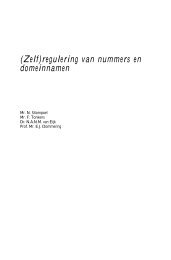
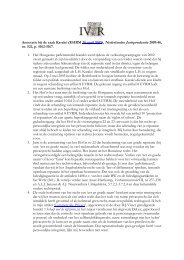

![Legal Opinion of Professor Egbert Dommering [1] concerning ... - IViR](https://img.yumpu.com/23603085/1/184x260/legal-opinion-of-professor-egbert-dommering-1-concerning-ivir.jpg?quality=85)
